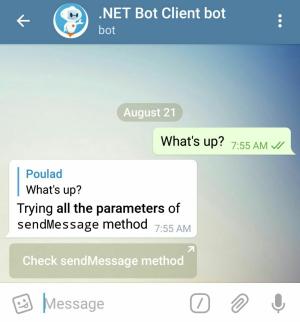Text Messages and More
Text is a powerful interface for your bot and sendMessage probably is the most used method of the Telegram Bot API.
Text messages are easy to send and fast to display on devices with slower networking.
Don't send boring plain text to users all the time. Telegram allows you to format the text using HTML or Markdown.
important
We highly recommend you use HTML instead of Markdown because Markdown has lots of annoying aspects
Send Text Message
The code snippet below sends a message with multiple parameters that looks like this:

You can use this code snippet in the event handler from Example Bot page and use
chatIdor put thechatIdvalue if you know it.
var message = await bot.SendMessage(chatId, "Trying <b>all the parameters</b> of <code>sendMessage</code> method",
ParseMode.Html,
protectContent: true,
replyParameters: update.Message.Id,
replyMarkup: new InlineKeyboardMarkup(
InlineKeyboardButton.WithUrl("Check sendMessage method", "https://core.telegram.org/bots/api#sendmessage")));
The method SendMessage of .NET Bot Client maps to sendMessage on Telegram's Bot API. This method sends a
text message and returns the message object sent.
text is written in HTML format and parseMode indicates that. You can also write in Markdown or plain text.
By passing protectContent we prevent the message (and eventual media) to be copiable/forwardable elsewhere.
It's a good idea to make it clear to a user the reason why the bot is sending this message and that's why we pass the user's
message id for replyParameters.
You have the option of specifying a replyMarkup when sending messages.
Reply markups are explained in details later in this book.
Here we used an Inline Keyboard Markup with a button that attaches to the message itself. Clicking that opens
sendMessage method documentation in the browser.
The Sent Message
Almost all of the methods for sending messages return you the message you just sent. Let's have a look at this object. Add this statement after the previous code.
Console.WriteLine(
$"{message.From.FirstName} sent message {message.Id} " +
$"to chat {message.Chat.Id} at {message.Date}. " +
$"It is a reply to message {message.ReplyToMessage.Id} " +
$"and has {message.Entities.Length} message entities.");
Output should look similar to this:
Awesome bot sent message 123 to chat 123456789 at 8/21/18 11:25:09 AM. It is a reply to message 122 and has 2 message entities.
There are a few things to note.
Date and time is in UTC format and not your local timezone.
Convert it to local time by calling message.Date.ToLocalTime() method.
Message Entity refers to those formatted parts of the text: all the parameters in bold and
sendMessage in mono-width font.
Property message.Entities holds the formatting information and message.EntityValues gives you the actual value.
For example, in the message we just sent:
message.Entities.First().Type == MessageEntityType.Bold
message.EntityValues.First() == "all the parameters"
Try putting a breakpoint in the code to examine all the properties on a message objects you get.

